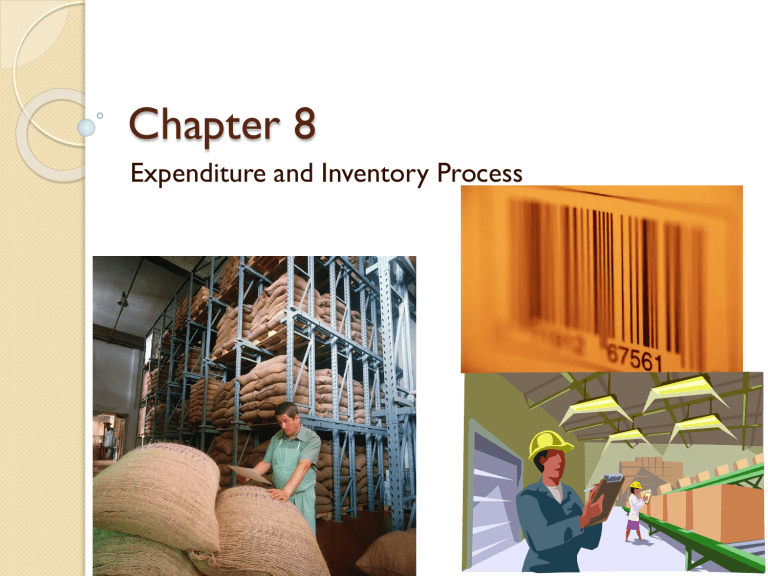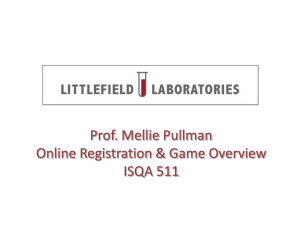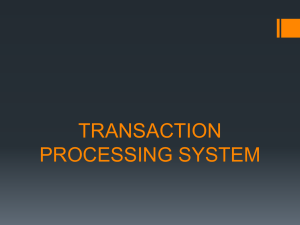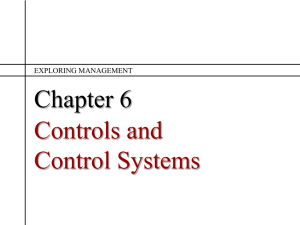Chapter 8

Chapter 8
Expenditure and Inventory Process
What are the 4 Activities in the
Expenditure Process?
◦ Determine the need for goods and services
◦ Select suppliers and Order goods/services
◦ Receive goods/services
◦ Pay suppliers of goods/services
Essential Questions:
How do companies keep track of their inventories they sell?
How do companies record the cost of their inventories?
Enduring Understandings:
A company must have an information system that captures data needed to report the effects of accounting events and to provide information to management
Why? To plan and control the activities of a business.
Enduring Understandings:
Whether you use a Perpetual or Period
Inventory System to track your inventory…….
Whether you use the Gross Method or
Net Price Method to record your inventory…….
SAME
Objectives:
Describe the difference through comparing and contrasting between the periodic and perpetual inventory systems.
Calculate and record inventory activities using each system.
Discuss the difference between the net price and gross price methods for recording inventory.
Calculate and record inventories using each method (gross vs. net)
Merchandising Vs. Manufacturing ?
Inventory purchased to be resold – BUY
Inventory purchased to be used to MAKE products
The Account for
Inventory is called,
“ Merchandise
Inventory ” OR
“ Inventory ”
◦ Ex. Clothes
The Account for
Inventory is called,
“ Direct Materials
Inventory ”
◦ Ex. IPhone – plastic cases
“Or Purchases ”
◦ glue
Decision # 1 - How do companies keep track of their inventories they sell?
PERPETUAL PERIODIC
Determine cost of goods sold and ending inventory on a continuous basis
“Running Balance”
Typically MORE expensive items
Determine ending inventory and cost of goods sold at the end of the period
Specific points in time
Typically LESS expensive items
Ex. Cars, Jewelry,
Computers
EX. – Grocery stores,
Dollar store items
Exercises 8.4 and 8.5
E8.4 Case 1: $54,000 + $72,000 = $126,000; $126,000 -
$41,000 = $85,000.
Case 2: $172,000 + $13,000 = $185,000; $185,000 -
$37,000 = $148,000.
Case 3: $88,000 + $26,000 = $114,000; $114,000 -
$67,000 = $47,000.
E8.5 Company A: $667,800 + $4,776,200 = $5,444,000;
$5,444,000 - $819,900 = $4,624,100.
Company B: $2,940,700 - $388,200 = $2,552,500;
$2,940,700 - $1,457,900 = $1,482,800.
Company C: $534,800 + $163,900 = $698,700;
$698,700 - $647,600 = $51,100.
Decision # 1 - How do companies keep track of their inventories they sell?
PERPETUAL PERIODIC
Purchases –
◦ “ Inventory Account”
Purchases-
“ Purchases Account”
Returns and Allowances
“ Inventory Account”
Freight (or insurance)
◦ “ Inventory Account”
Discounts of
◦ “ Inventory Account”
Returns and Allowances
“ Purchases and Returns
Account”
Freight (or insurance)
◦ “ Freight-in” or Insurance ”
Discounts of
◦
“ Purchase Discounts ”
Decision # 2 How do companies record the cost of their inventories?
ABC Company buys $9,000 of inventory with terms 2/10, n/30
PERPETUAL
Dr. Inventory $9,000
Cr. Acct. Payable $9,000
Inventory
$9,000
PERIODIC
Dr. Purchases $9,000
Cr. Acct. Payable $9,000
Purchases
$9,000
Decision # 2 -
How do companies record the cost of their inventories?
ABC pays $200 of freight to obtain the inventory
PERPETUAL
Dr. Inventory $200
Cr. Acct. Payable $200
PERIODIC
Dr. Freight-in 200
Cr. Cash $200
Inventory
$9,000
$200
Purchases Freight-in
$9,000 $200
Decision # 2 -
How do companies record the cost of their inventories?
ABC returns $800 of inventory because it is the wrong order
PERPETUAL
Dr. Acct. Payable $800
Cr. Inventory $800
PERIODIC
Dr. Acct. Payable $800
Cr. Purchase returns and allowances $800
Purchases Freight – in
Inventory
$9,000 $200
$9,000 $800
$200
Purchase Returns and Allowances
$800
Decision # 2 -
How do companies record the cost of their inventories?
ABC pays for the inventory
PERPETUAL
Dr. Acct. Payable $8,200
Cr. Cash $8,200
PERIODIC
Dr. Acct. Payable $8,200
Cr. Cash $8,200
Accounts Payable
$800 $9,000
$8,200
$8,200
$0.00
Accounts Payable
$800 $9,000
$8,200
$8,200
$0.00
With a perpetual system all events that affect the inventory are recorded as increases or decreases to:
A.
B.
C.
Purchases Account
Inventory Account
Separate temporary accounts depending on transaction: Purchases, Returns and
Allowances, Freight
With a periodic system all events that affect the inventory are recorded as increases or decreases to:
A.
B.
C.
Purchases Account
Inventory Account
Separate temporary accounts depending on transaction: Purchases, Returns and
Allowances, Freight
Which system must we make an adjustment for at the end of the period?
A.
Periodic Inventory
B.
Perpetual Inventory
Why must we make an inventory adjustment using the periodic method at the end of the period?
A.
B.
To update our inventory records for a current balance.
To update our inventory for items stolen or lost.
Decision # 2 - How do companies price (record) their inventories they sell?
Total Cost of inventory =
Full purchase price of inventory +
Freight paid to receive inventory +
Insurance paid on the inventory while in transit.
Decision # 2 - How do companies price (record) their inventories they sell?
GROSS PRICE NET PRICE
Full Cost (total cost)
Assumption: Discounts, when received are reductions in the purchase price of inventory
Discounted Cost
(total cost less discount available)
Assumption: ALL
Discounts should be taken.
Purchase discount recorded …..
WHEN TAKEN
Cost of inventory is the minimum amount due to the supplier.
Decision # 2 - How do companies price (record) their inventories they sell?
GROSS PRICE NET PRICE
If company, FAILS to take the discount, the extra amount is a
“finance charge” and is recorded as
“DISCOUNTS LOST”
Decision # 2 How do companies record the cost of their inventories?
ABC Company buys $9,000 of inventory with terms 2/10, n/30
PERIODIC -
GROSS PRICE
Dr. Purchases $9,000
Cr. Acct. Payable $9,000
Purchases
$9,000
PERIODIC-
NET PRICE
Dr. Purchases $8,820
Cr. Acct. Payable $8,820
(9,000 X 98% = 8,820)
Purchases
$8,820
Decision # 2 How do companies record the cost of their inventories?
ABC pays $200 of freight to obtain the inventory
PERIODIC
GROSS PRICE
Dr. Freight-in $200
Cr. Cash $200
PERIODIC
NET PRICE
Dr. Freight-in 200
Cr. Cash $200
Freight-in
$200
Freight-in
$ 200
Decision # 2 - How do companies record the cost of their inventories?
ABC returns $800 of inventory because it is the wrong order
PERIODIC PERIODIC
GROSS PRICE NET PRICE
Dr. Acct. Payable $800
Dr. Acct. Payable $784
Cr. Purchase returns and allowances $800
Cr. Purchase returns and allowances $784
(800 X 98% = 784)
Purchase Returns and Allowances
$800
Purchase Returns and Allowances
$784
Decision # 2 - How do companies record the cost of their inventories?
ABC pays for the inventory within the
PERIODIC discount period
PERIODIC
GROSS PRICE
NET PRICE
Dr. Acct. Payable $8,200
Dr. Acct. Payable $8,036
Cr. Purchase Discount $164
Cr. Cash $8,036
Cr. Cash $8,036
Accounts Payable
$9,000
$800
$8,200
$8,200
$0.00
Accounts Payable
$8,820
$ 784
$8,036
$8,036
$0.00
What is the Balance in Inventory under
Each Pricing Method?
With Discount Taken….
Net price
◦ Purchases $8,820
◦ Returns and Allowances - 784
◦ Ending value inventory $8,036
Gross price
◦ Purchases $9,000
◦ Returns and Allowances - 800
◦ Discounts - 164
◦ Ending value inventory $8,036
Decision # 2 - How do companies record the cost of their inventories?
ABC pays for the inventory AFTER the discount period expired.
PERIODIC
GROSS PRICE
Dr. Acct. Payable $8,200
Cr. Cash $8,200
Accounts Payable
$9,000
$800
$8,200
$8,200
$0.00
PERIODIC
NET PRICE
Dr. Acct. Payable $8,036
Dr. Discounts Lost $164
Cr. Cash $8,200
Accounts Payable
$8,820
$ 784
$8,036
$8,036
$0.00
What is the Balance in Inventory under
Each Pricing Method?
With Discount LOST or NOT TAKEN….
Net price
◦ Purchases $8,820
◦ Returns and Allowances - 784
◦ Ending value inventory $8,036
Gross price
◦ Purchases $9,000
◦ Returns and Allowances - 800
◦ Ending value inventory $8,200
Does this mean that the inventory under the gross price method is worth more?
◦ No, it simply reflects management’s beliefs concerning discounts.
Gross = cost reduction when taken
Net = financing cost when lost
Independent Practice:
Homework
A.
B.
Read 222-225
E 8.6, 8.7, 8.8, 8.9, E8.10








